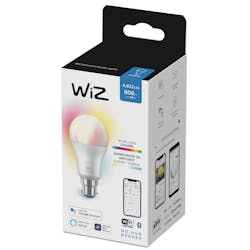Signify positions WiZ for broader mass market appeal than Hue, with lower prices (UPDATED)
Signify has taken a step to make it easier for consumers to set up WiZ, the lower-priced alternative to its Hue line of smart home lighting, as it positions WiZ for the broad mass market uptake that has eluded the higher-end Hue.
The company also announced general availability of the WiZ products that it unveiled earlier this year.
Addressing concerns that some consumers might find it tricky to pair their mobile phones with WiZ lights, Signify added a wireless Bluetooth connection that it says makes the process easy. Pairing is the process by which two devices know to recognize and work with each other.
Once the user couples their phone and the WiZ lights, Wi-Fi acts as the wireless control — as it always has with WiZ — via an app on the phone. Bluetooth is involved only in the setup.
“We have added Bluetooth for easy pairing, not for managing the lights itself,” a spokesperson explained to LEDs Magazine. “It just makes pairing the lights with the app even easier and more secure than before.”
Like Signify's Philips Hue line, which users can control via either Zigbee or Bluetooth wireless, WiZ includes bulbs on which users wirelessly dial up different colors, color temperatures, and brightness. Hue provides broader lighting scenarios than does WiZ, which Signify added to its portfolio in April 2019 when it acquired Hong Kong-based WiZ Connected.
With the announcement of WiZ Bluetooth pairing, Signify elaborated for LEDs on why it went for WiZ in the first place when it already had Hue. A spokesperson noted that WiZ provides a lower-priced, reduced-feature entree to smart lighting for consumers.
The home smart lighting market is still regarded as something of a high-end niche, even though Signify positions Hue through large mass market outlets like Home Depot and Best Buy.
The idea with WiZ is to increase mass market possibilities.
“Philips Hue is targeted at consumers looking for the latest trends and technologies, and expect the most from their smart home,” the spokesperson said. “Philips Hue offers the most comprehensive portfolio of smart lights, accessories, partners, and...possibilities to personalize. WiZ focuses on more functionally oriented consumers, looking for smart products that are accessible and easy to use. WiZ offers them an approachable smart lighting proposition (including bulbs, luminaires, accessories, and a broad range of partners) addressing the more functional lighting needs of a broad audience. It’s as easy to use as normal lighting.”
Earlier this year at the CES consumer electronics exhibition in Las Vegas, Signify added a raft of features to WiZ, including motion and ambient light sensors, an app that can manage a WiZ network and optimize energy savings, and a simple remote control that can allow even tech neophytes to easily manage room settings.
Those products are now available, having recently hit retail channels in Europe, the US, and Asia, Signify said.
One impediment to mass uptake of smart home lighting has been that it can be a hassle for consumers to set up the computer hubs necessary to deploy the traditional Zigbee-based Hue system.
To make Hue easier to set up, Signify added a hubless Bluetooth version of Hue in June 2019. But without the hub, users cannot tap into as many features as they can with the Zigbee hub. Signify's intention is for Bluetooth Hue users to upgrade to the Zigbee hub.
So Signify has put WiZ at the front of its ease-of-use charge.
“It’s really out-of-the-box, no hub, no hassle; users just need to download the app and can start using the lights,” the spokesperson said.
“Price is definitely a factor, too,” the spokesperson said. “WiZ offers less but is also more affordable so might be more accessible for some.”
Like-to-like comparisons are difficult. In an online price check by LEDs late last week, a combination white-and-color E27 Hue bulb listed at £49.99 ($US64.93), while WiZ listed a color E27 at €18.99 (£17.32 on Sept. 10; $22.50). A Hue white LED filament E27/A60 was £17.99 ($23.37), a WiZ was €13.99 (£12.76 on Sept. 10; $16.57). One Hue E14 white-only candle listed at £14.99 ($19.47), while a WiZ E14 candle white only went for €12.99 (£11.84 on Sept. 10; $15.38). A Hue white and color E14 candle listed at £49.99 ( 64.93 ), a WiZ color at €15.99 (£14.58 on Sept. 10; $18.94).
Hue's extra pricing also includes hubs and starters kits. A starter kit of one Hue E27 light with a bridge was listing for £119 ($154.54) on Sept. 10, for users who want the Zigbee hub version. WiZ does require a starter kit.
MARK HALPER is a contributing editor for LEDs Magazine, and an energy, technology, and business journalist ([email protected]).
*Updated Sept. 16, 2020 12:35 PM for market positioning clarification.
For up-to-the-minute LED and SSL updates, why not follow us on Twitter? You’ll find curated content and commentary, as well as information on industry events, webcasts, and surveys on our LinkedIn Company Page and our Facebook page.

Mark Halper | Contributing Editor, LEDs Magazine, and Business/Energy/Technology Journalist
Mark Halper is a freelance business, technology, and science journalist who covers everything from media moguls to subatomic particles. Halper has written from locations around the world for TIME Magazine, Fortune, Forbes, the New York Times, the Financial Times, the Guardian, CBS, Wired, and many others. A US citizen living in Britain, he cut his journalism teeth cutting and pasting copy for an English-language daily newspaper in Mexico City. Halper has a BA in history from Cornell University.





